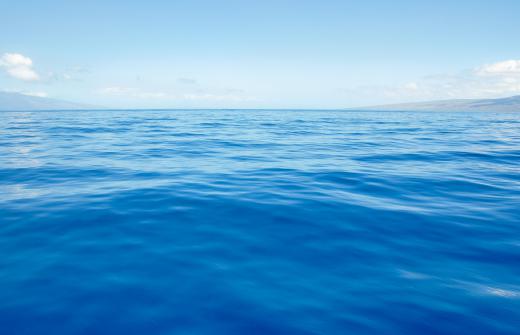What is Thermohaline Circulation?
 Mary McMahon
Mary McMahon
Thermohaline circulation is a very slow and extremely deep movement of water in the oceans around the world. A complete cycle can take thousands of years to complete from start to finish, with the cycle contributing a great deal to the mixing of the world's oceans. Thermohaline circulation appears to be linked to global climate and ocean health, as it mixes dissolved gases and minerals in the water and it may impact global temperatures as well.
When broken into its component roots, thermohaline refers to the temperature (thermo-) and dissolved salts (-haline) in ocean water. These salts are known as halides. Temperature and halinity of the water has an impact on its density, and this triggers thermohaline circulation. The colder water is, the more dense it is, and the saltier the water is, the higher the density. Because of thermohaline circulation, the Atlantic Ocean is denser than the Indian and Pacific oceans, making it slightly lower.

The cycle starts around the equator in the Pacific Ocean, when surface currents like the jet stream slowly drive water westwards. This water is warm and not terribly salty, making it lightweight, so that it floats on the surface of the ocean. As the water goes west, it slowly works its way into the North Atlantic, where it cools due to ambient temperatures. In addition, the salinity increases, through evaporation.
This combination of factors causes the water to slowly sink to the bottom of the ocean. It also slowly begins to move south, as it is pushed by more sinking water from the surface current. Some of the dense, cold water settles into deep ocean basins, but the bulk of it slowly circulates southwards before moving east, around the Horn of Africa and back to the site where it originated; some of the water slips around Australia to emerge in the South Pacific, while the other part of the deep ocean current winds its way through the Indian Ocean. As the water cycles, it becomes warmer and less salty, until it upwells in the Pacific only to start the cycle all over again.
Some people have raised concerns about the impact of global warming on thermohaline circulation. There is some concern that an increase in glacier melt could lower the halinity of the ocean in the North Atlantic, causing the cycle to shut down. This may lead to localized cooling in the Northern Hemisphere, which could have serious repercussions for the organisms which live there.
AS FEATURED ON:
AS FEATURED ON:











Discussion Comments
anon25443: A good question. I believe the article indicates that the salt concentrations in the north Atlantic would drop with the introduction of above-normal levels of glacial melt due to global warming. Then rather than sink in the typical manner while circulating southward, the water would remain at or near the ocean surface, shutting down the cycle.
Hey, great paper! It's like the third one I've read and I actually understand this one! My question is the problem with thermohaline circulation... Is the north going to heat up causing the halinity to decrease, or is it going to cool down causing the halinity to decrease. Probably a stupid question, but worth a shot!
Post your comments